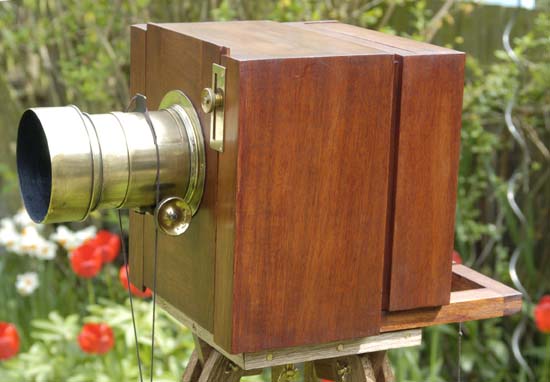
Mahogany half plate Sliding Box Camera with Dallmeyer 2B Lens
The Dallmeyer Portrait lens was made in 1862, the camera in January 2004
Although it is fairly easy to find original lenses designed for the wet collodion process, the situation with cameras is very different. Original cameras dating from the 1850s or 1860s are rare and very expensive, and far too important to be used in the field some 140 years after they were made.
So, the wet collodion photographer anxious, when demonstrating the process, to use equipment that faithfully represents that used in the 1860s has few options to follow. Either make the cameras and associated equipment himself or purchase it from an experienced maker of wet collodion equipment*.
George Eastman House Photographic Museum web site has an excellent online display of early cameras and it is not difficult to find suitable models to copy.
The example above is known as a sliding box camera because the camera body is made up of two boxes, one sliding within the other. This type of camera is typical of the kind that travelling photographers of the period would have used. They were relatively inexpensive and robust. Instead of using bellows the coarse focus was achieved by adjusting the sliding box, fine focus was achieved by adjusting the lens.

The next camera shown is a whole plate (8 1/2"x6 1/2") camera with rise and fall front. This is made of American Cherry and has leatherette bellows.
The lens shown is a Dallmeyer Patent portrait lens. The aperture is f3 with a focal length of 11 1/2".
A number of other lenses can be used with this camera.
A Dallmeyer Triple Achromat for group and architectural photographs.
A Dallmeyer Wide Angle Landscape lens for landscape photography.

The stereo camera shown has two different sets of lenses.
Those shown are pair of Darlot portrait lenses.
It can also be fitted with a pair of rapid rectilinear lenses for groups and views.


Finally my 12"x10" camera with swing and tilt back.
This is shown, on the left, with a Dallmeyer 3D Patent Portrait lens.
The set up, seen on the right, used to take my first 12"x10" negative, used an 18" Dallmeyer Rapid Rectilinear lens
Below my first 12"x10" negative, taken using a Dallmeyer Rapid Rectilinear lens.

The result, a gold toned silver gelatine print.
I am always willing to consider making a wet collodion camera in either mahogany or American cherry.
*If you are interested in having cameras, or any other eqipment suitable for the Wet Collodion process made, contact me and I will provide an estimate.
To see some of the ambrotypes and ferrotypes I have produced please go to my results page
To see some examples of my work made from negatives please visit my other results page
To see some details of my developing box and my camp set up, please go to my equipment page
Please view my Frederick Scott Archer page.
Return to my home page